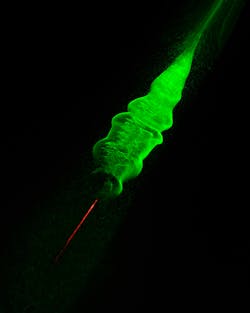NONLINEAR OPTICS: Short-pulse lasers cause condensation in air

Femtosecond lasers could have a new trick to add to the arsenal of effects they produce: They may be able to make it rain. A European research team has shown that the filaments produced by focusing short laser pulses in air can cause water from the air to condense spontaneously.
Among the many nonlinear effects that short-pulse lasers can produce, filamentation is one of the more spectacular. Self-focusing of a short pulse occurs due to the nonlinearity of the refractive index in air, bringing the pulse into sharper focus until the local field is high enough to ionize air itself; the recombination of the ions and their electrons makes for bundles of "filaments" along the direction of beam propagation, spreading to distances up to hundreds of meters.
Now, Jerome Kasparian of the University of Geneva (Switzerland) and his colleagues have shown that these filaments can cause water to spontaneously condense out of the air. As Kasparian points out, this condensation effect is not so new; Lord Wilson discovered more than 100 years ago that cosmic rays can spur condensation in much the same way, because the cosmic rays ionize the air as they pass.
"Since the high-power lasers ionize the air, we speculated that they could also initiate condensation in saturated atmospheres," says Kasparian. To test that, the team—made up of researchers from the University of Geneva, the Free University of Berlin (Germany), and the University of Lyon (France)—used a "cloud chamber" in which the humidity and temperature could be controlled.
First test: Supersaturated air
The researchers preconditioned a 10 Hz train of 220 mJ, 60 fs pulses at an 800 nm wavelength with a negative spectral chirp into the chamber, forming bundles of 20 to 30 filaments as the nonlinear interactions refocused the beam. The team first set the humidity to beyond saturation—a relative humidity of 230%—and the temperature to -24°C.
"When we launched the laser beam into the chamber with a saturated atmosphere, we were quite surprised that we not only generated some droplets but even got an effect which was largely visible with the naked eye," Kasparian says.
The group then measured the size of the droplets induced by the filaments using an aerosol particle sizer. They found that the volume of water in the beam volume increased by a factor of 100 in 3 s of droplet evolution.
It was a notable result but perhaps not so surprising given the oversaturation of the atmosphere. However, Kasparian said the team went on to attempt the same experiment in atmospheres with just 70–90% relative humidity at temperatures between 20° and 60°C.
"Our surprise was even larger when we observed that the condensation of droplets was even visible in atmospheres not saturated with water, which were much more representative of the real atmosphere."
Aiming at the sky
The results were repeated again in actual atmospheric conditions, firing the group's Teramobile laser upward into the skies over Berlin, with filamentation occurring at heights between 45 and 75 m. The team infers the rise in droplet numbers in the beam by measuring the backscattering from the propagation direction, which they measure at a significant fraction of a percent.1
The precise mechanism of condensation remains a mystery, though the team says there are hints that the charged particles act as condensation nuclei due to the charges, and that oxidative photochemistry involving trace gases like sulfur dioxide or even nitrogen may play a role.
Kasparian concedes that the result is not the same as "seeding" precipitation in the way that airborne cloud-seeding approaches clearly do. But he says that by sweeping the beam to increase its effective volume, the same effect may well be possible.
"Investigations on the mechanism of the laser-induced condensation should help us to optimize the laser pulses—pulse duration, wavelength, energy, and so on—as well as determine the more favorable conditions to get the larger effect," he says.
Moreover, once those conditions are well-characterized, the effect could be used in reverse, for obtaining hard data about the atmosphere in remote sensing applications.
"The effect of the laser on condensation strongly depends on the atmospheric conditions, especially relative humidity and temperature," Kasparian explains. "As a consequence, detecting the generated droplets and characterizing their density and sizes bears information about the atmospheric conditions. Detecting aerosols with remote sensing is quite easy, so this may provide a way to get access to the atmospheric parameters remotely."
REFERENCE
- P. Rohwetter et al., Nature Photon., DOI: 10.1038/nphoton.2010.115.